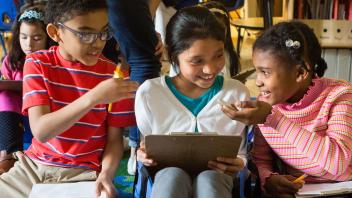Key Information
Focus
When To Use This Strategy
Appropriate Group Size
What is listen-read-discuss?
Listen-read-discuss is a comprehension strategy that builds students’ prior knowledge before they read a text. It supports both listening and reading comprehension by introducing a new topic in three stages. During the first stage, students listen as you present the content of their reading through a lecture, often paired with a graphic organizer. Next, students read a text selection about the topic. After reading, there is a whole group or small group discussion about the topic, where students compare and contrast the information from the lecture with the information they read.
Why use listen-read-discuss?
- It helps students comprehend material presented orally.
- It builds students’ prior knowledge before they read a text.
- It engages struggling readers in classroom discussions.
- It engages students in active learning, where they need to think about the information in relation to different points-of-view — the teacher, the author, and other students.
- This simple, flexible strategy can be used across all curriculum areas with almost any text.
How to use listen-read-discuss
- Listen: Present information to students about the book they will be reading. This can be in the form of a short lecture on the topic, using a graphic organizer to guide the lecture.
- Read: Ask students to read a text selection. The content should be similar to the material presented during the “listen” portion of the lesson.
- Discuss: Lead a classroom discussion of the material. Encourage students to reflect on any differences between their reading of the content and your presentation. You can also have the class break into smaller groups for the discussion.
Watch a lesson (small group)
Fairfax County teachers from Lynbrook Elementary School discuss the power of student talk. Providing students opportunities to listen to and communicate with each other helps them co-construct their understanding. (Fairfax County Public Schools)
Differentiate instruction
For second language learners, students of varying reading skill, and younger learners
- Include a graphic organizer of the information you discuss.
- Identify subjects that your students need more support with and pre-select the text to align with your students’ needs.
See the research that supports this strategy
Manzo, Anthony V., & Casale, Ula P. (1985). Listen-Read-Discuss: A content reading heuristic. Journal of Reading, 28, 372-734.
